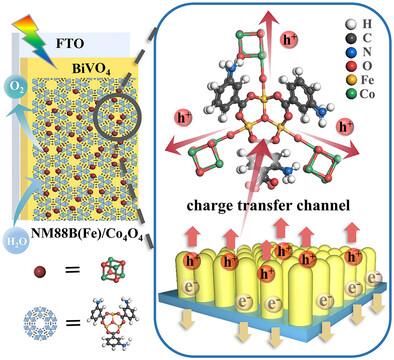BiVO4和{Co4O4} Cubanes之间共价键介导的界面电荷转移增强了光电化学水分解
IF 19
1区 材料科学
Q1 CHEMISTRY, MULTIDISCIPLINARY
引用次数: 0
摘要
尽管分子共催化剂(MCs)在光电化学(PEC)水分解中显示出巨大的应用潜力,但其长期应用的固定化和稳定化仍然是一个挑战。本文通过位点隔离策略将Co4O4 cubanes固定在NH2-MIL-88B(Fe) (NM88B(Fe))修饰的BiVO4上,制备了集成光阳极(BiVO4@NM88B(Fe)/Co4O4)。NM88B(Fe)中未占据的配位位点与Co4O4和BiVO4共价结合,显著降低了BiVO4@NM88B(Fe)/Co4O4的界面电荷转移阻力,实现了长时间的稳定性。更重要的是,析氧助催化剂(OEC) NM88B(Fe)/Co4O4显著降低了能垒,在热力学上有利于地表水氧化。在1.23 VRHE下,BiVO4@NM88B(Fe)/Co4O4光阳极的光电流密度达到5.26 mA·cm−2,是裸BiVO4光电流密度的3.73倍。这项工作提出了一种位点隔离策略,以克服PEC系统中分子催化剂稳定性的挑战,同时为设计oec和半导体之间有效的电荷转移通道以提高水分解性能提供了重要见解。本文章由计算机程序翻译,如有差异,请以英文原文为准。

Covalent Bonding Mediated Interfacial Charge Transfer Between BiVO4 and {Co4O4} Cubanes for Enhanced Photoelectrochemical Water Splitting
Although molecular cocatalysts (MCs) have demonstrated significant application potential for photoelectrochemical (PEC) water splitting, the immobilization and stabilization of them for long-term application remains challenging. Herein, an integrated photoanode (BiVO4@NM88B(Fe)/Co4O4) is developed by immobilizing Co4O4 cubanes onto NH2-MIL-88B(Fe) (NM88B(Fe)) decorated BiVO4 via site-isolation strategy. The unoccupied coordination sites in NM88B(Fe) covalently bound to both Co4O4 and BiVO4, which significantly decreases the interfacial charge transfer resistance of BiVO4@NM88B(Fe)/Co4O4 and achieve prolonged stability. More importantly, the oxygen evolution cocatalyst (OEC) NM88B(Fe)/Co4O4 remarkably lowered the energy barrier and thermodynamically favored surface water oxidation. Consequently, the photocurrent density of BiVO4@NM88B(Fe)/Co4O4 photoanode achieved up to 5.26 mA·cm−2 at 1.23 VRHE, which is 3.73 times higher than that of bare BiVO4. This work presents a site-isolation strategy to overcome molecular catalyst stabilization challenges in PEC systems while offering crucial insights into designing efficient charge transfer channels between OECs and semiconductors for enhanced water splitting performance.
求助全文
通过发布文献求助,成功后即可免费获取论文全文。
去求助
来源期刊

Advanced Functional Materials
工程技术-材料科学:综合
CiteScore
29.50
自引率
4.20%
发文量
2086
审稿时长
2.1 months
期刊介绍:
Firmly established as a top-tier materials science journal, Advanced Functional Materials reports breakthrough research in all aspects of materials science, including nanotechnology, chemistry, physics, and biology every week.
Advanced Functional Materials is known for its rapid and fair peer review, quality content, and high impact, making it the first choice of the international materials science community.
 求助内容:
求助内容: 应助结果提醒方式:
应助结果提醒方式:


